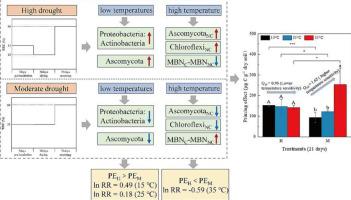当前位置:
X-MOL 学术
›
Sci. Total Environ.
›
论文详情
Our official English website, www.x-mol.net, welcomes your
feedback! (Note: you will need to create a separate account there.)
Influence of drought intensity on soil carbon priming and its temperature sensitivity after rewetting
Science of the Total Environment ( IF 8.2 ) Pub Date : 2023-11-07 , DOI: 10.1016/j.scitotenv.2023.168362 Rui Zhang 1 , Rong Li 1 , Jialiang Kuang 1 , Zhenqing Shi 1
Science of the Total Environment ( IF 8.2 ) Pub Date : 2023-11-07 , DOI: 10.1016/j.scitotenv.2023.168362 Rui Zhang 1 , Rong Li 1 , Jialiang Kuang 1 , Zhenqing Shi 1
Affiliation

|
Global climate change can affect the soil thermal and moisture condition, potentially disrupting microbial-mediated soil respiration and altering the soil C cycle. However, the complex relationship between the soil C turnover and transient thermal and moisture conditions is not fully understood. Specifically, quantitative understanding is lacking regarding the impact of drought-rewetting events and temperature on the response of soil organic carbon (SOC) decomposition rate to exogenous C input, known as the priming effects (PEs). Herein, we quantified glucose-induced PEs during the rewetting of soils incubated under two drought intensities [with 20 % and 33 % water holding capacity (WHC)], at different incubation temperatures (15, 25, and 35 °C). Moreover, the effect size of drought intensities on PEs and the temperature sensitivity of PEs were quantified using ln (Response Ratio) and Q of PEs. Glucose input triggered positive PEs after 21 d incubation and increased SOC decomposition by 29.7–72.7 %. Drought intensity showed positive effect (ln > 0) on PEs at lower temperatures (15 and 25 °C) but showed negative effect (ln < 0) on PEs at higher temperature (35 °C). At moderate drought intensity (33 % WHC) before rewetting, PEs increased significantly with incubation temperature (Q = 1.65). Contrastingly, at high drought intensity (20 % WHC), temperature did not significantly influence PEs during the 21-d incubation after rewetting (Q = 0.96). The combination of drought, temperature change and glucose addition significantly changed the abundances in the dominant bacterial phyla (, , and ) and fungal phylum (), which likely affect PEs. Furthermore, the decrease in the demand for microbial-driven N mining, which is a crucial factor in promoting positive PEs, was associated with drought intensity at high temperature (35 °C). Our study provided a quantitative and mechanistic understanding of the impact of drought intensity on PEs before rewetting and its temperature sensitivity.
中文翻译:

干旱强度对土壤碳启动及其回湿后温度敏感性的影响
全球气候变化会影响土壤的温度和湿度状况,可能会破坏微生物介导的土壤呼吸并改变土壤碳循环。然而,土壤碳周转与瞬态热量和水分条件之间的复杂关系尚未完全了解。具体而言,关于干旱再湿事件和温度对土壤有机碳(SOC)分解速率对外源碳输入的响应(称为启动效应(PE))的影响缺乏定量了解。在此,我们量化了在两种干旱强度[分别为 20% 和 33% 持水能力 (WHC)]、不同培养温度(15、25 和 35 °C)下培养的土壤再润湿过程中葡萄糖诱导的 PE。此外,干旱强度对PE的影响大小和PE的温度敏感性使用PE的ln(响应比)和Q进行量化。孵育 21 天后,葡萄糖输入触发正 PE,并使 SOC 分解增加 29.7-72.7%。干旱强度在较低温度(15 和 25 °C)下对 PE 表现出积极影响(ln > 0),但在较高温度(35 °C)下对 PE 表现出消极影响(ln < 0)。在再润湿前的中等干旱强度 (33% WHC) 下,PE 随孵化温度的升高而显着增加 (Q = 1.65)。相比之下,在高干旱强度(20% WHC)下,在再润湿后的 21 天孵化期间,温度对 PE 没有显着影响(Q = 0.96)。干旱、温度变化和葡萄糖添加的结合显着改变了优势细菌门(、、和)和真菌门()的丰度,这可能会影响 PE。此外,微生物驱动的氮开采需求的减少是促进正 PE 的关键因素,与高温(35°C)下的干旱强度有关。我们的研究提供了对再润湿前干旱强度对PE的影响及其温度敏感性的定量和机制理解。
更新日期:2023-11-07
中文翻译:

干旱强度对土壤碳启动及其回湿后温度敏感性的影响
全球气候变化会影响土壤的温度和湿度状况,可能会破坏微生物介导的土壤呼吸并改变土壤碳循环。然而,土壤碳周转与瞬态热量和水分条件之间的复杂关系尚未完全了解。具体而言,关于干旱再湿事件和温度对土壤有机碳(SOC)分解速率对外源碳输入的响应(称为启动效应(PE))的影响缺乏定量了解。在此,我们量化了在两种干旱强度[分别为 20% 和 33% 持水能力 (WHC)]、不同培养温度(15、25 和 35 °C)下培养的土壤再润湿过程中葡萄糖诱导的 PE。此外,干旱强度对PE的影响大小和PE的温度敏感性使用PE的ln(响应比)和Q进行量化。孵育 21 天后,葡萄糖输入触发正 PE,并使 SOC 分解增加 29.7-72.7%。干旱强度在较低温度(15 和 25 °C)下对 PE 表现出积极影响(ln > 0),但在较高温度(35 °C)下对 PE 表现出消极影响(ln < 0)。在再润湿前的中等干旱强度 (33% WHC) 下,PE 随孵化温度的升高而显着增加 (Q = 1.65)。相比之下,在高干旱强度(20% WHC)下,在再润湿后的 21 天孵化期间,温度对 PE 没有显着影响(Q = 0.96)。干旱、温度变化和葡萄糖添加的结合显着改变了优势细菌门(、、和)和真菌门()的丰度,这可能会影响 PE。此外,微生物驱动的氮开采需求的减少是促进正 PE 的关键因素,与高温(35°C)下的干旱强度有关。我们的研究提供了对再润湿前干旱强度对PE的影响及其温度敏感性的定量和机制理解。





















































 京公网安备 11010802027423号
京公网安备 11010802027423号